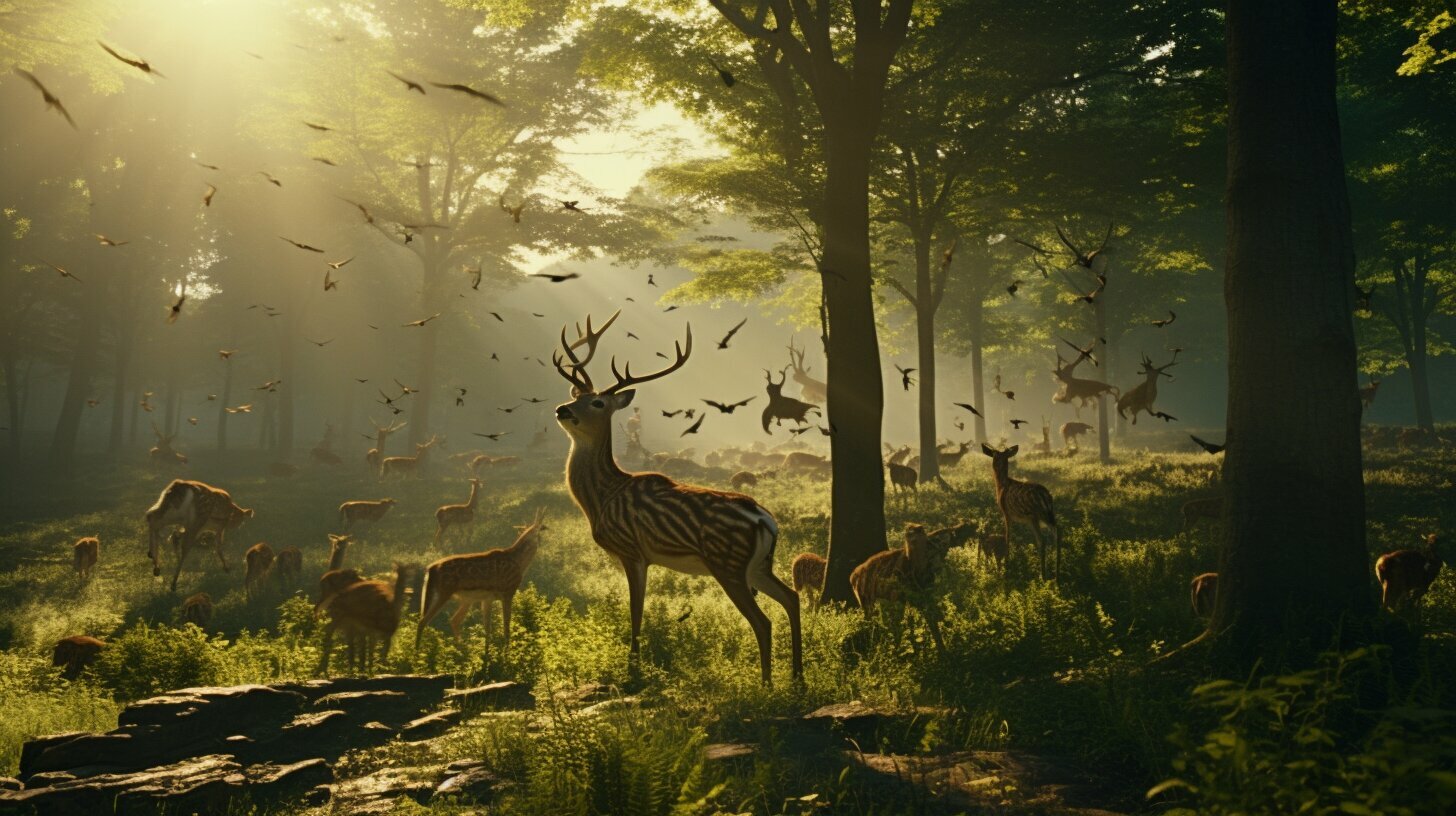Unraveling the Mystery: Why Do Deer Run in Circles?
Have you ever wondered why deer have a tendency to run in circles, seemingly without a clear direction? It’s a fascinating behavior that has puzzled researchers and nature enthusiasts alike. In this article, we will explore the various reasons behind this intriguing deer running behavior and shed light on the mystery.
Key Takeaways:
- Deer running in circles can be attributed to various factors.
- Chronic Wasting Disease (CWD) is a neurological disease that can cause deer to exhibit circular running behavior.
- Running in circles can be a defensive tactic used by deer to evade predators and make it harder for them to target an individual deer.
- During the rut, bucks may exhibit circular movements as they search for potential mates.
- Understanding deer behavior, including their movement patterns and reaction to external stimuli, is crucial for hunting or observing them.
- While caution should be exercised in consuming venison from areas with CWD prevalence, there is currently no scientific evidence of CWD transmission to humans through consumption.
- Unraveling the mystery of why deer run in circles involves considering factors such as disease, predation, and rut-related behaviors.
Fascinating and complex, the behavior of deer running in circles is rooted in a variety of factors. From the neurological condition of Chronic Wasting Disease (CWD) to their evasive tactics against predators, deer exhibit this behavior for survival and reproductive purposes. By understanding their movement patterns and behavior, we gain valuable insights into their world. While there are cautions to consider, the mystery of why deer run in circles continues to intrigue us, reminding us of the wonders of the natural world.
The Curious Behavior of Deer
Deer are fascinating creatures, known for their graceful movements and elusive nature. One peculiar behavior that has puzzled researchers and wildlife enthusiasts alike is the phenomenon of deer running in circles. This circular running behavior can be attributed to various factors, shedding light on the intricate nature of these majestic animals.
One reason for deer running in circles is chronic wasting disease (CWD), a neurological condition that affects deer populations. Similar to scrapie in sheep and mad cow disease in cattle, CWD causes deer to exhibit symptoms such as circling, drooling, staggering, and emaciation. It is believed that the damage CWD inflicts on the deer’s brain and nervous system disrupts their normal behavior, leading to the circular running pattern.
Another explanation for the circular running behavior is the predator threat. When deer are faced with imminent danger, they instinctively employ evasive tactics to confuse and escape their predators. Running in circles makes it harder for predators to target a single deer, as their circular movement disorients and confuses potential threats.
During the rut, the mating season for deer, bucks may exhibit wandering behavior in loops or circles. This behavior can be attributed to their intense drive to find potential mates. As they navigate through their territory in search of receptive does, bucks may unintentionally create circular movements in their quest for love.
It’s important to note that while CWD and predator threat are contributing factors to deer running in circles, not all cases of circular running are related to these factors. Understanding deer behavior, including their movement patterns and reaction to external stimuli such as shots, can provide valuable insights when hunting or observing these magnificent creatures.
To summarize, the curious behavior of deer running in circles stems from a combination of factors, including chronic wasting disease, predator evasion, and behavioral patterns during the rut. By unraveling the mystery behind this behavior, we gain a deeper understanding of the complex nature of deer and their interactions with their environment.
Chronic Wasting Disease and Circular Running
One possible explanation for deer running in circles is the presence of chronic wasting disease (CWD), a debilitating condition affecting these majestic animals. CWD is a neurological disease that primarily affects deer, and is comparable to scrapie in sheep and mad cow disease in cattle. It is caused by abnormal proteins called prions, which damage the brain and nervous system of infected animals.
Deer suffering from CWD may exhibit a range of symptoms, including circling, drooling, staggering, and emaciation. This disease can cause significant behavioral changes in affected deer, leading them to run in repetitive circular patterns. These circular movements may be a result of the neurological damage caused by CWD, affecting the deer’s ability to navigate and respond to their environment in a normal manner.
It’s important to note that not all cases of deer running in circles are related to CWD. However, the presence of this disease should be considered as a potential factor when trying to understand this behavior. Wildlife management agencies and researchers are actively studying CWD and its impact on deer populations, as well as potential transmission risks to other species.
To combat the spread of CWD, it is crucial to implement effective disease surveillance and management strategies. This includes monitoring deer populations for signs of the disease, establishing containment zones, and implementing hunting regulations to help control the spread of CWD. While research is ongoing, it is currently recommended that hunters exercise caution when consuming venison from areas where CWD is known to be prevalent. However, it’s worth noting that there is currently no scientific evidence to suggest that CWD can be transmitted to humans through consumption.
| CWD Facts and Figures |
|---|
| CWD is found in both captive and wild deer populations. |
| The disease has been detected in deer in 26 U.S. states. |
| It is estimated that CWD can remain infectious in the environment for years. |
| Chronic wasting disease is not limited to deer; it has also been found in elk, moose, and reindeer. |
In summary, the circular running behavior observed in deer can be attributed to various factors, one of which is chronic wasting disease. The neurological damage caused by CWD can lead to altered movement patterns and repetitive circular behaviors. Understanding this disease and its impact on deer populations is crucial for effective wildlife management and conservation efforts.
Predator Threat and Evasive Tactics
When faced with imminent danger, deer have evolved a remarkable escape strategy – running in circles. This behavior serves as a defensive tactic that makes it more difficult for predators to single out and target an individual deer. By running in circles, deer create confusion and disorient their pursuers, ultimately increasing their chances of survival.
Deer are highly agile and possess incredible speed, allowing them to execute swift maneuvers as they flee from predators. Running in circles is just one of the many evasive tactics employed by deer to outsmart their pursuers. This strategy, combined with their natural ability to navigate through dense vegetation and unpredictable terrain, makes it challenging for predators to catch them.
However, it’s important to note that not all instances of deer running in circles are solely related to predator threats. Other factors, such as chronic wasting disease (CWD) or specific behavioral patterns during the rut, can also contribute to this behavior. CWD is a neurological disease that affects deer, causing symptoms such as circling, drooling, staggering, and emaciation. Although the exact mechanisms behind the circular running behavior associated with CWD are not fully understood, it is believed to be a result of the impact this disease has on the deer’s brain and nervous system.
| Predator Threat and Evasive Tactics |
|---|
| Running in circles |
| Increases chances of survival |
| Creates confusion and disorientation for predators |
| Agility and speed are crucial |
| Ability to navigate through dense vegetation and unpredictable terrain |
Understanding deer behavior is vital for hunters and wildlife enthusiasts alike. By studying their movement patterns and reactions to external stimuli, such as gunshots, one can gain valuable insights into their behavior and optimize observation or hunting strategies. Additionally, caution should be exercised when consuming venison in areas where CWD is prevalent. While there is currently no scientific evidence to suggest that CWD can be transmitted to humans through consumption, it is recommended to follow local guidelines and regulations to ensure the safety of the meat.
In conclusion, the mystery behind why deer run in circles involves various factors, including predator threats, disease, and behavioral patterns during the rut. Running in circles is a remarkable escape strategy employed by deer to evade predators, increasing their chances of survival. It is a testament to their adaptability and resourcefulness in the face of danger.
The Rut and Circular Movements
The rut, also known as the breeding season, introduces unique behaviors in deer, including wandering in loops or circles. This behavior is primarily observed in bucks as they search for potential mates. During the rut, bucks become more active and may cover large distances in search of receptive does. This increased activity can sometimes result in them moving in loops or circles.
Patterns of Circular Movements
While the exact reasons behind the circular movements during the rut are not fully understood, researchers have observed certain patterns. Bucks may establish a core area and frequently make rounds within it, marking their territory and searching for signs of receptive does. These circular movements can also help bucks pick up on the scent of does, as they move in a circular pattern to maximize their chances of detecting the pheromones left by females in heat.
Additionally, bucks may engage in what is known as “following circles,” where they walk in a circular path while trailing a doe. This behavior is believed to be a way for bucks to guard the doe against rival bucks and ensure they are the sole suitor for mating. Following circles can also serve as a means of courting the doe and assessing her receptiveness.
The Role of Territory and Hormones
During the rut, bucks are highly territorial and engage in various behaviors to establish dominance and secure mating rights. Their movements in loops or circles are often a way to assert their presence within their territory and ward off rival males. Hormonal changes, such as a surge in testosterone, play a significant role in shaping these behaviors.
| Common Rut Behaviors | Explanation |
|---|---|
| Rubbing and scraping trees | Bucks mark their territory and leave visual and scent cues for other deer. |
| Chasing other deer | Bucks pursue rivals to establish dominance and gain mating rights. |
| Grunt calls and vocalizations | Bucks use vocalizations to attract does and intimidate rival males. |
Understanding these behaviors during the rut can provide valuable insights for hunters and wildlife enthusiasts alike. By studying the patterns of circular movements and territorial behaviors, individuals can better predict deer movements and increase their chances of successful hunting or observation.
Understanding Deer Behavior
To truly comprehend why deer run in circles, it’s crucial to gain insights into their behavior and how they interact with their surroundings. Deer running patterns can be influenced by various factors, including disease, predation, and behavioral patterns during the rut.
One reason for deer running in circles is chronic wasting disease (CWD), a neurological disease that affects deer. Comparable to scrapie in sheep and mad cow disease in cattle, CWD causes deer to exhibit symptoms such as circling, drooling, staggering, and emaciation. When infected with CWD, deer may engage in circular running behavior as a result of the impairment caused by the disease.
Another reason for deer running in circles is their response to predation threats. Running in circles can be an evasive tactic employed by deer to make it harder for predators to target an individual deer. By constantly changing direction and running in loops, deer increase their chances of escaping from potential threats.
During the rut, bucks may also exhibit circular movements while searching for potential mates. It is believed that this behavior may be a result of bucks marking their territory and assessing the presence of receptive does in the area. These circular movements during the rut are a part of their natural behavioral patterns and contribute to the intriguing nature of deer running behavior.
In Conclusion
Understanding deer behavior, including their movement patterns and reactions to external stimuli, is key to unraveling the mystery behind why deer run in circles. Factors such as disease, predation, and the rut all play a role in shaping this behavior. While chronic wasting disease is a legitimate concern for deer populations, caution should be exercised by hunters when consuming venison in areas where CWD is prevalent. However, it’s important to note that there is currently no scientific evidence to suggest that CWD can be transmitted to humans through consumption. By studying and observing deer behavior, we can gain a deeper appreciation for these majestic creatures and better understand their fascinating running patterns.
Cautions and Considerations
As hunters, it’s essential to be aware of potential risks associated with consuming venison in regions affected by chronic wasting disease (CWD). This neurological disease, comparable to scrapie in sheep and mad cow disease in cattle, can cause deer to exhibit symptoms such as circling, drooling, staggering, and emaciation. While there is currently no scientific evidence to suggest that CWD can be transmitted to humans through consumption, caution should still be exercised.
When hunting in areas where CWD is prevalent, it is advisable to take certain precautions. Firstly, it is recommended to avoid consuming the brain, spinal cord, and lymph nodes of deer, as these are the tissues most likely to harbor the infectious prions responsible for CWD. Secondly, it is important to properly handle, process, and cook venison to minimize any potential risks. Cooking meat to an internal temperature of 160°F (71°C) can help ensure the destruction of any pathogens that may be present.
Table: CWD Prevalence and Recommendations
| Prevalence | Recommendations |
|---|---|
| Low | Consume venison as usual, practicing standard food safety precautions. |
| Moderate | Consider testing deer for CWD before consumption. If a deer tests positive, it is advisable to avoid consuming the meat. |
| High | Avoid consuming venison altogether to minimize potential risks. |
It’s also important to remember that not all cases of deer running in circles are related to CWD. Predation can also be a reason for this behavior, as running in circles makes it more challenging for predators to target an individual deer. During the rut, bucks may exhibit circular movements as they search for potential mates. Understanding deer behavior, including their movement patterns and reaction to shots, can be valuable knowledge when hunting or observing them.
In conclusion, while CWD may be a concern for hunters, it is crucial to stay informed and take appropriate precautions. By practicing proper handling and cooking techniques, hunters can continue to enjoy venison while minimizing potential risks. Unraveling the mystery of why deer run in circles involves considering various factors, including disease, predation, and behavioral patterns during the rut. By understanding these factors, hunters and wildlife enthusiasts can gain a deeper appreciation for these fascinating creatures and ensure their own well-being.
Unraveling the Mystery
The behavior of deer running in circles is influenced by a multitude of factors, making it a fascinating mystery to uncover. One significant factor is chronic wasting disease (CWD), a neurological condition that affects deer and shares similarities with scrapie in sheep and mad cow disease in cattle. Symptoms of CWD include circling, drooling, staggering, and emaciation, which can contribute to deer running in repetitive patterns.
Another reason for deer exhibiting circular running behavior is predation. When faced with a threat, deer may instinctively run in circles, making it difficult for predators to single out an individual deer. This evasive strategy helps increase the deer’s chances of survival by confusing and disorienting predators.
During the rut, bucks may wander in loops or circles while searching for potential mates. This behavior is associated with their breeding instincts and the need to cover a larger area in search of receptive does. These circular movements during the rut further add to the enigma of deer running in circles.
It’s important to note that not all cases of deer running in circles are related to CWD. Understanding deer behavior, including their movement patterns and reactions to external stimuli like shots, can provide valuable insights for hunters and observers. Caution should be exercised when consuming venison in areas where CWD is prevalent, although scientific evidence currently does not support transmission to humans through consumption.
| Reasons for Deer Running in Circles |
|---|
| Chronic Wasting Disease (CWD) |
| Predator threats and evasive tactics |
| Rut-related circular movements |
As we strive to unravel the mystery of deer running in circles, it becomes clear that multiple factors contribute to this intriguing behavior. Disease, predation, and rut-related behaviors all play a role. By comprehending these factors and studying deer behavior, we can gain a deeper understanding of their movements and enhance our hunting and observational experiences.
Implications for Hunting and Observation
Whether you are a hunter or an avid observer of wildlife, understanding deer behavior, including their circular running tendencies, can greatly enhance your experience. By recognizing the reasons behind deer running in circles, you can better anticipate their movements and make informed decisions about when and where to observe or hunt these majestic creatures.
One significant factor that may contribute to circular running in deer is chronic wasting disease (CWD). This neurological condition affects deer and can result in symptoms such as circling, drooling, staggering, and emaciation. While not all instances of deer running in circles are connected to CWD, being aware of this disease and its implications can help you assess the overall health of the deer population in your area and take appropriate precautions.
Additionally, circular running in deer can be a defense mechanism against predators. Running in circles makes it more challenging for predators to single out and target an individual deer, increasing their chances of survival. By understanding this behavior, you can gain insights into deer evasive tactics and plan your hunting or observation strategy accordingly.
During the rut, bucks may also exhibit circular movements as they search for potential mates. By recognizing and interpreting these behaviors, you can gain valuable knowledge about buck activity and potentially increase your chances of encountering them during this exciting time of year.
| Reasons for Deer running in circles: | Implications for Hunting and Observation: |
|---|---|
| Chronic Wasting Disease (CWD) | Assess overall health of deer population |
| Predator threat | Understand deer evasive tactics |
| The rut | Gain insights into buck activity |
While enjoying your time in the great outdoors, it’s essential to be cautious about consuming venison in areas where CWD is prevalent, even though there is currently no scientific evidence to suggest transmission to humans through consumption. Stay informed about the prevalence of CWD in your region and follow any guidelines or recommendations from local authorities.
Overall, understanding deer behavior and the reasons behind their circular running tendencies can provide valuable insights for both hunters and wildlife enthusiasts. By incorporating this knowledge into your hunting or observation practices, you can enhance your experience and develop a deeper appreciation for these fascinating creatures.
Conclusion
In conclusion, the reasons behind deer running in circles are diverse, including factors like chronic wasting disease, predator evasion, and behavioral patterns during the rut.
One significant factor is chronic wasting disease (CWD), a neurological disease that affects deer and is comparable to scrapie in sheep and mad cow disease in cattle. Deer with CWD may exhibit symptoms such as circling, drooling, staggering, and emaciation. It is crucial to understand this disease and its impact on deer behavior when studying their running patterns.
Another reason for deer running in circles is their natural instinct to evade predators. Running in circles makes it harder for predators to target an individual deer, as the constant change in direction and speed creates confusion and reduces the chances of being caught. This behavior serves as a defense mechanism for survival.
Additionally, during the rut, which is the breeding season for deer, bucks may exhibit circular movements as they search for potential mates. This behavior is driven by hormone levels and the need to find receptive does. Understanding deer behavior during this time can provide valuable insights into their running patterns.
While some cases of deer running in circles are related to CWD and predator evasion, it is crucial to note that not all instances are. Factors such as habitat, weather conditions, and individual deer behavior can also influence their running patterns. It is essential for hunters and observers to have a comprehensive understanding of deer behavior, including movement patterns and reactions to external stimuli like shots.
Hunters should exercise caution when consuming venison in areas where CWD is prevalent, although there is currently no scientific evidence to suggest that CWD can be transmitted to humans through consumption. Overall, unraveling the mystery of why deer run in circles involves considering various factors, including disease, predation, and behavioral patterns during the rut.
FAQ
Why do deer run in circles?
Deer may run in circles for various reasons. One reason is chronic wasting disease (CWD), a neurological disease that affects deer and can cause symptoms such as circling, drooling, staggering, and emaciation. Another reason is when deer are threatened by predators, running in circles makes it harder for predators to target an individual deer. Additionally, during the rut, bucks may wander in loops or circles when looking for does.
Can chronic wasting disease (CWD) cause deer to run in circles?
Yes, chronic wasting disease (CWD) can cause deer to exhibit circular running behavior. CWD is a neurological disease that affects deer and is comparable to scrapie in sheep and mad cow disease in cattle. Deer with CWD may exhibit symptoms such as circling, drooling, staggering, and emaciation.
Why do deer run in circles when threatened by predators?
When deer are threatened by predators, running in circles is a defensive strategy. By running in circles, deer make it more challenging for predators to target a single deer. This evasive tactic can confuse and deter predators, increasing the chances of escape for the deer.
Do deer run in circles during the rut?
Yes, during the rut, bucks may exhibit circular movements as they search for potential mates. These circular movements are part of the bucks’ behavior when they are looking for does. It is believed to be a way for bucks to cover more ground and increase their chances of finding receptive females.
Should hunters be cautious about consuming venison in areas with chronic wasting disease (CWD)?
It is recommended that hunters exercise caution when consuming venison in areas where chronic wasting disease (CWD) is prevalent. Although there is currently no scientific evidence to suggest that CWD can be transmitted to humans through consumption, it is prudent to follow guidelines and recommendations from local health authorities and wildlife management agencies.
How can understanding deer behavior be helpful when hunting or observing them?
Understanding deer behavior, such as their movement patterns and their reactions to external stimuli, can be beneficial when hunting or observing them. By understanding their behavior, hunters can anticipate their movements and increase their chances of a successful hunt. Observers can also gain valuable insights into deer behavior and appreciate these magnificent creatures in their natural habitat.
Are all cases of deer running in circles related to chronic wasting disease (CWD)?
No, not all cases of deer running in circles are related to chronic wasting disease (CWD). There are various reasons for deer exhibiting circular running behavior, including predation threats and behavioral patterns during the rut. It is important to consider multiple factors when trying to understand why deer run in circles.
- Discovering Why Do Women Wear Lipstick: A Deeper Look - 19/12/2023
- Why Do Golfers Only Wear One Glove? - 16/12/2023
- Why Don’t Hobbits Wear Shoes? - 14/12/2023
Hi, I’m Rhiannon, the lead author behind The News Wire. As a passionate journalist, I strive to bring you the latest news and updates from all over the world. With a keen eye for detail and a dedication to unbiased reporting, I aim to deliver well-researched and informative articles that keep you informed and engaged. From breaking news to in-depth analyses, I cover a wide range of topics with the aim of keeping you in the loop. Join me on The News Wire as we explore the dynamic and ever-changing landscapes of global events, uncovering the stories that matter most.






